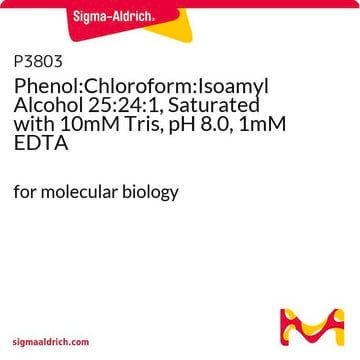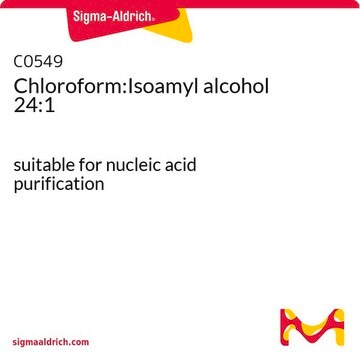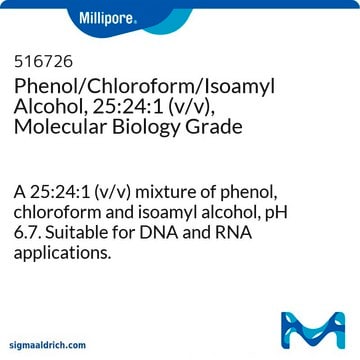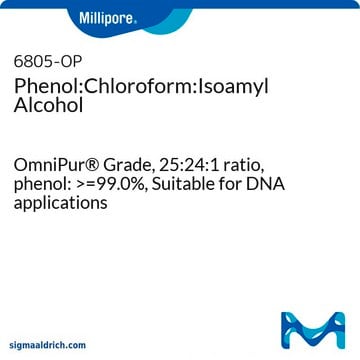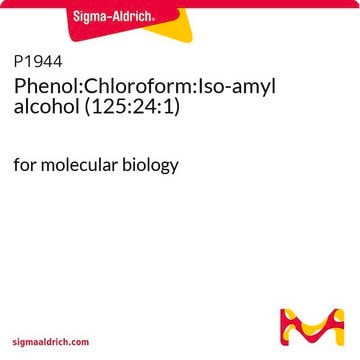Please see the link below to review the product datasheet. Note that the prepration instructions require the addition of the entire vial (6.5 mL) of equilabration buffer to the contents of the product. Aliquot immediately after the gentle mixing step. During the 2 - 4 hour incubation period the mixure will phase separate. At this point the aliquots may be stored for long term use according to the instructions.
https://www.sigmaaldrich.com/deepweb/assets/sigmaaldrich/product/documents/144/892/p2069dat.pdf
P2069
Phenol:Chloroform:Isoamyl Alcohol 25:24:1 Saturated with 10 mM Tris, pH 8.0, 1 mM EDTA
Supplied with Equilibration buffer, for molecular biology
Synonym(s):
DNA extraction
Select a Size
$119.00
Estimated to ship onMarch 29, 2025
Select a Size
About This Item
$119.00
Estimated to ship onMarch 29, 2025
Recommended Products
grade
for molecular biology
Quality Level
assay
≥99.0%
form
liquid
pH
6.5-6.9(pH of phenolic phase)
7.8-8.2(pH of phenolic phase after the addition of Equilibration Buffer)
application(s)
agriculture
storage temp.
2-8°C
Application
Packaging
Suitability
Preparation Note
Other Notes
related product
signalword
Danger
Hazard Classifications
Acute Tox. 3 Oral - Acute Tox. 4 Dermal - Acute Tox. 4 Inhalation - Aquatic Chronic 2 - Carc. 2 - Eye Dam. 1 - Muta. 2 - Repr. 2 - Skin Corr. 1B - STOT RE 1 Oral - STOT RE 2 - STOT SE 3
target_organs
Central nervous system, Liver,Kidney, Nervous system,Kidney,Liver,Skin
Storage Class
6.1A - Combustible acute toxic Cat. 1 and 2 / very toxic hazardous materials
wgk_germany
WGK 3
flash_point_f
Not applicable
flash_point_c
Not applicable
Choose from one of the most recent versions:
Already Own This Product?
Find documentation for the products that you have recently purchased in the Document Library.
Customers Also Viewed
Protocols
Method for reverse transcription of RNA into DNA. Uses a premixed reagent that contains reverse transcriptase, dNTPs, primers, RNase inhibitor and buffer. Fast generation of cDNA.
-
After equilibrating with the supplied Tris buffer, can I aliquot this for use, if so, should I just top each aliquot with additional Tris pH 8?
1 answer-
Helpful?
-
-
I ordered Product P2069, Phenol:Chloroform:Isoamyl Alcohol 25:24:1; I got one bottle of the Phenol:Chloroform:Isoamyl Alcohol and one bottle of B5658, Equilibration buffer. When and how am I supposed to use the B5658?
1 answer-
B5658 is a Tris buffer that is used to raise the pH of the phenol:chloroform:isoamyl alcohol mixture, to make it suitable for isolation of genomic DNA. The contents of the two bottles need to be well mixed. Then allow the mixture to separate; this may take 2-4 hours. This procedure should raise the pH of the phenol phase from 6.7 to about 8.0. Only one "treatment" is needed. This solution should be stable for up to 12 months.
Helpful?
-
-
There are two layers in the bottle of Product P2069, Phenol:Chloroform:Isoamyl Alcohol 25:24:1; which layer should I use?
1 answer-
The lower phase is the phase that is to be used.
Helpful?
-
-
What is the Department of Transportation shipping information for this product?
1 answer-
Transportation information can be found in Section 14 of the product's (M)SDS.To access the shipping information for this material, use the link on the product detail page for the product.
Helpful?
-
-
There is an Equilibration Buffer (Product B5658) that is included with Product P2069, Phenol:Chloroform:Isoamyl Alcohol 25:24:1. Is B5658 also available separately?
1 answer-
No, it is only available as part of P2069.
Helpful?
-
-
I see that you list two equilibrated Phenol:Chloroform:Isoamyl alcohol products. When should I use Product P3803, and when should I use Product P2069?
1 answer-
In short, P3803 is for RNA work, and P2069 is for DNA work. Product P2069 consists of one bottle of Product P3803 and one bottle of Product B5658. The B5658 is added to the P3803 to raise the pH of the organic phase from 6.7 to 8.0; pH 8.0 is not suitable for RNA work, because RNA can degrade at the higher pH.
Helpful?
-
Active Filters
Our team of scientists has experience in all areas of research including Life Science, Material Science, Chemical Synthesis, Chromatography, Analytical and many others.
Contact Technical Service